
The Sonoran Desert is a hot desert in North America and ecoregion that covers the northwestern Mexican states of Sonora, Baja California, and Baja California Sur, as well as part of the southwestern United States. It is the hottest desert in both Mexico and the United States. It has an area of 260,000 square kilometers (100,000 sq mi).
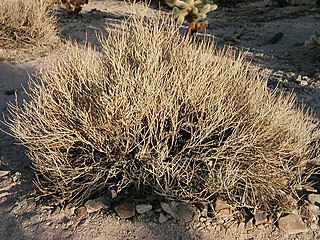
Senna covesii is a perennial subshrub in the family Fabaceae, native to the Mojave Desert and Sonoran Desert in southeastern California, southern Nevada, and Arizona in the United States, and northern Baja California in Mexico. It is found on desert plains and in sandy washes between 500 and 600 m above sea level, and is very common in Joshua Tree National Park. The specific epithet honors ornithologist Elliott Coues.

Parkinsonia florida, the blue palo verde, is a species of palo verde native to the Sonoran Deserts in the Southwestern United States and Northwestern Mexico. Its name means "green pole or stick" in Spanish, referring to the green trunk and branches, that perform photosynthesis.

Penstemon parryi, the Parry's penstemon, Parry's beardtongue or desert penstemon, is a wildflower native to the Sonoran Desert of Southern Arizona and northern Mexico. It is a perennial that blooms in March and April. In the wild, plants flower in their second year. In cultivation, flowering is often achieved in the first year if seed is planted in the autumn.
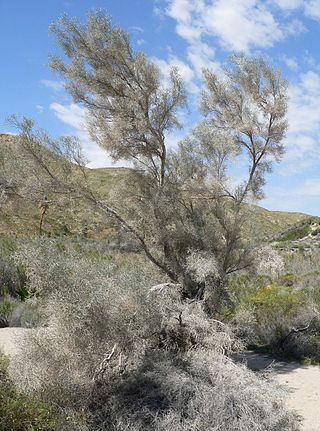
Psorothamnus spinosus, or Delea spinosa, is a perennial legume tree of the deserts in North America. Common names include smokethorn, smoketree, smoke tree, smokethorn dalea, and corona de Cristo.

Atriplex hymenelytra, the desert holly, is silvery-whitish-gray shrub in the family Amaranthaceae, native to deserts of the southwestern United States. It is the most drought tolerant saltbush in North America. It can tolerate the hottest and driest sites in Death Valley, and remains active most of the year.

The Lower Colorado River Valley (LCRV) is the river region of the lower Colorado River of the southwestern United States in North America that rises in the Rocky Mountains and has its outlet at the Colorado River Delta in the northern Gulf of California in northwestern Mexico, between the states of Baja California and Sonora. This north–south stretch of the Colorado River forms the border between the U.S. states of California/Arizona and Nevada/Arizona, and between the Mexican states of Baja California/Sonora.

Condea emoryi, the desert lavender, is a large, multi-stemmed shrub species of flowering plant in Lamiaceae, the mint family.
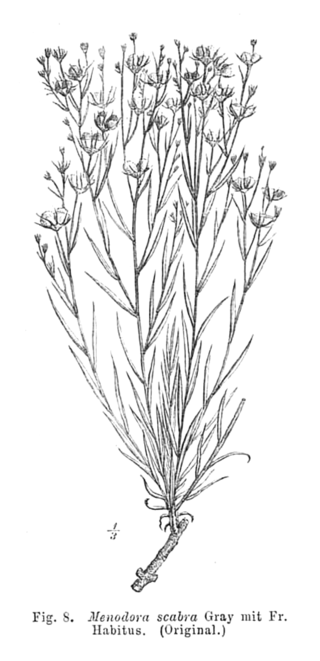
Menodora scabra is broom-like shrub in the Olive Family (Oleaceae), known by the common name rough menodora or broom twinberry. It is a popular desert garden plant.

Celtis ehrenbergiana, called the desert hackberry or spiny hackberry, is a plant species that has long been called C. pallida by many authors, including in the "Flora of North America" database. It is native to Arizona, Florida, New Mexico and Texas, and to Latin America as far south as central Argentina. It grows in dry locations such as deserts, brushlands, canyons, mesas and grasslands.
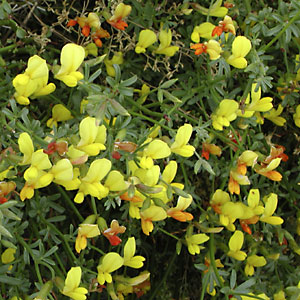
Acmispon rigidus, synonyms Lotus rigidus and Ottleya rigida, is a flowering plant in the pea family (Fabaceae), native to the southwestern United States and northwestern Mexico. It is known as shrubby deervetch or desert rock-pea. It is found in the Mojave Desert and Sonoran Desert.
Flora of the Sonoran Desert includes six subdivisions based on vegetation types. Two are north of the boundary between the United States and Mexico, and four are south of the boundary. The flora of the Colorado Desert are influenced by the environment of the very dry and hot lower areas of the Colorado River valley, which may be barren, treeless, and generally have no large cacti. Flora of the Arizona Upland are comparatively lush, with trees and large columnar cacti that can withstand winter frosts. Those subdivisions of the Sonoran Desert which lie south of the international border are characterized by plants that cannot withstand frost.
Flora of the Arizona Upland includes higher elevation Sonora Desert plants that require more moisture and cooler climates than those of the adjacent Sonoran Desert areas in the Colorado Desert of the lower Colorado River valley area, and which can withstand frost, unlike plants of the Sonoran Desert south of the border between the United States and Mexico.

Trichostema arizonicum, the Arizona bluecurls, is a perennial plant in the mint family (Lamiaceae) native to the Southwestern United States and northwestern Mexico. It has striking curling flowers and can often be found along road sides. The genus name means "hair stems" in reference to the graceful stamens that curl around to dab pollen on the backs of insect pollinators.

Euphorbia florida, the Chiricahua milk spurge or Chiricahua Mountain sandmat, is an annual plant in the spurge family (Euphorbiaceae) found in the Sonoran Desert of the mountains of southern Arizona and north-western Mexico.

Cnidoscolus angustidens, with the common name mala mujer, is an herbaceous perennial plant in the spurge family (Euphorbiaceae).
Dalea neomexicana, the downy prairie clover, is a perennial plant in the legume family (Fabaceae) found in the Sonoran Desert and grasslands of southeastern Arizona to western Texas and into Mexico. Its common name refers to its silky hairs covering it.
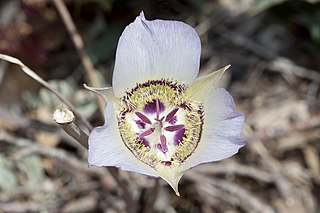
Calochortus ambiguus, the Arizona mariposa lily or doubting mariposa lily, is a perennial plant in the lily family (liliaceae) that grows at higher elevations of the Sonoran Desert regions of Arizona, western New Mexico, southern Utah, and Sonora.
Ambrosia cordifolia, called the Tucson bur ragweed, is a North American species of plant in the family Asteraceae. It is native to northern Mexico and the State of Arizona in the United States.















